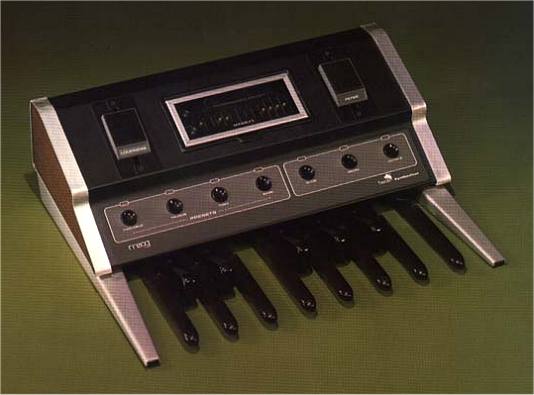- The Moog Taurus Pedal Synthesizer lets you
make music with your feet while your hands are busy
playing keyboard, guitar, or drums. The Taurus has three programmed
voices and a voice that you can
program completely In performance you can select a Moog voice or your
voice instantly The Taurus is
a variable synthesizer that features two audio oscillators to create
phasing effects, parallel intervals, and
rich percussion sounds. In addition, functions like glide, decay and
pedalboard octave may be switched
by foot during performance. And its five octave range makes Taurus
more than a bass instrument. Add
another dimension to your control over sound-add a Moog Taurus 1 pedal
synthesizer.
TAURUS FEATURES
Three pre-programmed synthesizer voices: Bass, Tuba, and Taurus
· One fully programmable voice. You create the sound and
pre-set it yourself.
· Five octave range-16' 8' 4' 2' and 1'
· Foot sliders for loudness and tone color variation.
· Ultra stable oscillator design: less than one cent (0.06%)
short term drift, less than two cents (0.18%)
long term drift.
· Electronic preset selectors. Presets never have to be cancelled.
- MAINTENANCE
- Built like a tank and with rock solid oscillators
the Taurus pedals doesn't require much attention. A couple of issues
are important though - the Taurus is aging and some care may be necessary
after all. The tips below are stuff I've tried out myself, but I will
not be held responsible for the outcome of your own efforts should
you choose to try this yourself.
- 1. The contact board.
- The contacts on the pedal keyboard are made
of silver. Silver is great for its conductivity, but as your mother
will tell you, black tarnish will build up as a result of prolonged
contact with air (oxygen). Ordinary contact spray doesn't do diddely
to that kind of tarnish. As a result of this, many owners think their
Taurus are broken. Ofcourse regular use may keep the tarnish from
building up, but again - you may go on holiday only to come back and
find that several pedals are no longer working. The solution is ordinary
tarn-remover made for cleaning silverware. I think spray is best.
Carefully disassemble the pedals, and pull out the contact board.
Clean the contacts and rinse with tap water. Dry it off, and leave
it to dry for at least 48 hours before reassembly.
- 2. The pedals.
- Made of plastic these may brake. You can easily
replace them with wooden copies, but hey that would make your precious
instrument less original. My advice is that you always place the pedals
on some carpet. The pedals are lesser prone to breakage that way.
- 3. Restauring the exteriours.
- This tip can be used for a lot of old gear,
tolex-covered thingys and so on. The aluminum frame surrounding the
pedals can be cleaned using ordinary steel wool. With or without soap.
If you're using water, you should disassemble the unit and keep the
electronic parts dry. I recon water is not necessary though. For rinsing,
cleaning and restoring the plasitc cover I recommend using Armour
All (originally made for dashboards in cars). For cleaning the plastic
pedals I'm using polish ment for hard plastics applied with a sponge.
The plastic parts are ofcourse removed from the synth for cleaning.
3

|

